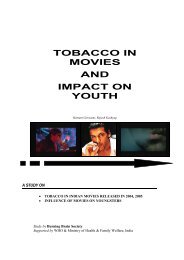Professional Report - Smoke Free Movies
Professional Report - Smoke Free Movies
Professional Report - Smoke Free Movies
Create successful ePaper yourself
Turn your PDF publications into a flip-book with our unique Google optimized e-Paper software.
each out to millions of film-crazy youngsters. This is particularly significant because increasingly tobacco<br />
brands are finding it difficult to advertise in the mainstream media.<br />
Indian cinema in many instances unwittingly glamorised tobacco usage. The trend began in the early 1950s<br />
when the superstars of the times, Ashok Kumar, Dev Anand and Raj Kapoor, were portrayed smoking<br />
cigarettes and cigars in their films. Smoking was associated with romance, style, tragedy and rebellion. In<br />
South Indian films too, cigarettes have long been associated with style and sophistication. Smoking as a style<br />
accessory in South Indian films was first used in a 1949 film titled Velai Kari. The association has only grown<br />
stronger over the years, reaching a pinnacle with superstar Rajnikanth’s much-imitated act of tossing a<br />
cigarette in his mouth and lighting up. Rajnikanth’s “stylish” way of lighting up in movies of the late ‘80s enjoys<br />
instant recall and adulation among the youth even today.<br />
In Bollywood, with the arrival of Amitabh Bachchan in the 1970s, the anti-hero came into his own. Traditionally,<br />
the anti-hero -was characterised by the two acknowledged vices – smoking and drinking. This helped identify<br />
him as the anti-hero and lent him an aura of rebellion which had its own appeal with youngsters. While villains<br />
drank and smoked as part of well-established signifying codes, they were not always appealing or worthy of<br />
emulation – unlike Amitabh Bachchan’s characters who were powerful and charismatic. Bachchan’s characters<br />
in countless movies represented the marginalized and the oppressed. He was a man on a mission of justice.<br />
He wore his angst on his sleeve and smoking was an act of rebellion. Through blockbuster films such as<br />
Deewaar, Coolie and Sholay, Bachchan turned into a “working class” hero and the bidi became a part of the<br />
Bachchan persona.<br />
After Amitabh Bachchan a string of actors continued the angry young man’s fight. The anti-hero of the 1970’s<br />
continued into the 1980’s but with a difference – his mission was personal vendetta. The films of Sunny Deol<br />
and Sanjay Dutt who bridged the gap between the late 1980’s and the 1990’s portrayed two facets of the hero.<br />
The hero was both the hardcore vigilante and the romantic with a soft inner core. Due to the duality of their<br />
characterisation they inhabited a hazy space – often filled with smoke from their cigarettes.<br />
By the 1990’s the entry of Shahrukh Khan gave a new twist to the anti-hero tale. In films such as Baazigaar<br />
and Darr, he was a wronged young man, a disturbed young lover rejected by society or the woman he loved<br />
which left him emotionally and psychologically scarred. Briefly, smoking formed a part of Khan’s on-screen<br />
persona, until he emerged as the romantic boy next door in films like Dilwale Dulhaniya Le Jayenge, Kuch<br />
Kuch Hota Hai and Devdas, whose box-office collections smashed all records. Though Khan rarely smokes on<br />
screen in his candyfloss romances, he is often photographed smoking in his press and TV interviews.<br />
Film stars in India lead very public lives. Several aspects of the Indian film industry, including film inaugural<br />
functions, information about shooting locales, love lives and heart breaks in the industry, favorite foods of the<br />
stars, where they shop, where they holiday etc., receive substantial media coverage. Film stars have huge fan<br />
followings and this mass support enables many to build a successful political career. Some stars like<br />
Rajnikanth in the South, even have temples dedicated to their glory. The new generation of actors is selling<br />
images of healthiness. They are all brawn and biceps and they all smoke. Smoking has got a new lease of life<br />
and it often seems as if smoking is being promoted as a healthy habit. Film stars from Bollywood as well as the<br />
South, have been used in tobacco advertisements. The fact that superstars such as Shahrukh Khan, Ajay<br />
Devgan, Sanjay Dutt and Rajnikanth smoke off-screen has helped establish a strong triangular relationship<br />
between their public image, their personal lives and tobacco. Recognising this relationship, tobacco companies<br />
have gone to the extent of providing famous actors with a free life time supply of cigarettes<br />
Approach to the Research.<br />
Films and filmstars have a huge impact on the lives of youth. This study is aimed at understanding the extent to<br />
which movies impact youth lifestyles and the impact of portrayal of tobacco in films.<br />
It is therefore necessary to estimate the actual number of incidents of smoking in movies. A content analysis of<br />
the films -records the number of tobacco incidents; the type of tobacco used; the situations, moods and<br />
locations in which these incidents -are portrayed. Brand usage and demographic details of characters using<br />
tobacco on screen –are the other important criteria. -A homogeneous sample of films have been selected for<br />
viewing so as to enable comparison. The top 30-35 top films – comprising of the biggest revenue earners of<br />
the year – -have been viewed for the 12-year period 1991 to 2002. This particular timeframe –has been<br />
selected as it -coincides with teenagers’ exposure to movies during their growing up years.<br />
9



